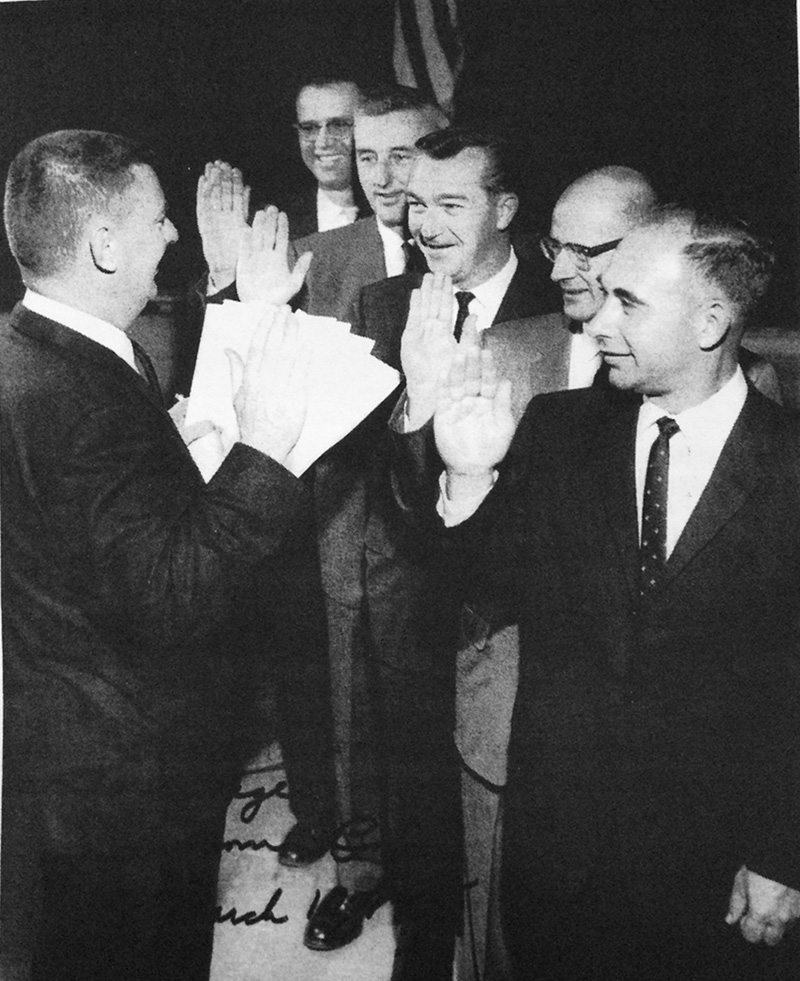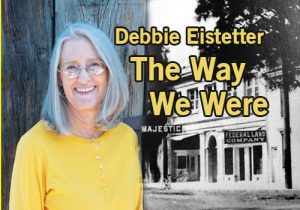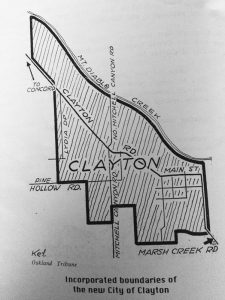Clayton celebrates 60th anniversary since incorporating as a city in 1964

 CLAYTON, CA (Feb. 16, 2024) — If you look closely at a Contra Costa County map of Clayton’s city boundaries, you’ll notice a strange little cutout on its western border.
CLAYTON, CA (Feb. 16, 2024) — If you look closely at a Contra Costa County map of Clayton’s city boundaries, you’ll notice a strange little cutout on its western border.
Located on this northeast corner of Kirker Pass Road and Clayton Road is a gas station whose address is in Concord in spite of the fact that all the businesses on the same corner are in Clayton. The situation goes back to Clayton’s 1964 incorporation and its quest for an identity of its own.
California was experiencing a building boom following WWII, and “cherry stem annexation” was a legal way for a city to annex, by way of roads and easements, those properties whose owners were interested in receiving services like sewer, utilities and police. Businesses that earned revenue and paid taxes – like gas stations – were especially prized.
As farming in the Clayton Valley dwindled, large landholdings became available and were ripe for the development of housing and business centers. The city of Concord was anxious to expand eastward, and many Clayton residents became increasingly worried that their small town would be swallowed up and be known only as “East Concord.”
At a meeting in 1959, the Concord City manager touted Clayton’s annexation to Concord as a good move for all parties. However, the Clayton residents who attended saw no need for the city services offered and did not want the additional property taxes that came with them.
A foresighted group of Clayton residents knew Concord’s expansion would continue. Using their own funds, they sought a professional analysis to determine if incorporation would be attainable for Clayton.

In May 1960, the county boundary commission approved a petition to hold an election to incorporate. But it was struck down when two quarries within the proposed city boundaries declined to be included in the proposal.
In 1961, Pleasant Hill incorporated as a city – thwarting Concord’s western expansion. This victory provided hope for Clayton residents to continue the fight. Clayton leaders lobbied the state Legislature to approve a bill that would require a more orderly way to establish boundaries for annexations and incorporation.
New fodder fueling the flames for incorporation occurred when Nan Wallace, a Clayton resident, happened to see a small article in the Oakland Tribune announcing that Concord was poised to annex Cardinet Glen. The 25 acres of land located near the DeMartini winery building, Clayton’s current City Hall, was to become part of Concord using the “cherry stem” method by creeping along Clayton Road.
State law dictated a stem could only extend a half mile from the annexing city’s border, and this stem barely reached by including the Clayton home of the Concord city attorney. It would have divided Clayton in half and prevented any further attempt to incorporate.
The Clayton group filed a notice of intention to incorporate, and a group of Clayton residents drove to the State Capitol to speak with the Assemblyman representing Clayton and Concord. He was of the opinion that the Cardinet Glen annexation was most likely not valid. Concord withdrew the annexation.
Wallace formed an incorporation committee, and Clayton pursued incorporation with renewed vigor. Meetings at Wallace’s house resulted in the study of the operations of other small California towns, public informational meetings, the use of a telephone network to ensure an audience at hearings in Martinez, flier distributions and the collection of funds for the election.
A second petition to incorporate included only a half square mile boundary, smaller than the 1960 petition. They crafted it to exclude those surrounding subdivisions that posed a danger to its passage.
Clayton became a city when the votes were tallied on March 3, 1964: 251 for incorporation, 61 opposed. This municipal election set a record in the state of California with 91% of registered voters having cast ballots.
Residents rang the old school bell on the hill above town to announce the victory, and more than 80 folks partied at the home of Clayton’s first mayor, Bob Hoyer. The mayor and Clayton City Council were sworn in at Endeavor Hall on March 18, 1964.
This article is a mere summary of the fine booklet “The Story of Clayton,” which Eldora and Bob Hoyer wrote in 1999. It records in detail the steps toward incorporation and the names of all the dedicated people who acted with vision and perseverance. Copies are available for sale in the Clayton Museum.
Current Mayor Jim Diaz is helping plan a 60th anniversary celebration in conjunction with the July 4th parade. He encourages anyone who wants to volunteer to contact City Hall.
As the city turns 60 this March, our first mayor will turn 103 years old. Always personable, possessed of infinite knowledge and a heck of a bocce player, we salute you, Bob.
For more information or to become a member, visit claytonhistory.org. The Clayton Museum is open 2-4 p.m. Wednesdays and Sundays at 6101 Main St.. Admission is free.

Debbie Eistetter
Debbie Eistetter has been a resident of Clayton for almost 30 years. She serves on the Board of the Clayton Historical Society and believes that history shows us the way to a more enlightened present and hopeful future. For more information about the CHS Museum please visit claytonhistory.org
